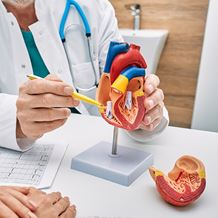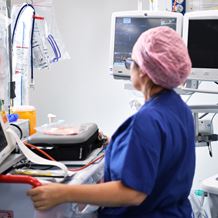
- Home
- Services
- Cardiac Services
- Procedures and Treatments
- Septal Defect Closure
What is are septal defect closures?
Septal defect closures are surgical treatments that repair a hole in the heart. These are known as septal defects. There are various different techniques that can be used which include closing the hole with a special device, using a synthetic patch, or stitching it shut. The operation can either be performed non-invasively using a special catheter, or through open heart surgery. The technique and approach will depend on the individual condition and will vary by patient.
What does it do?
Septal defect closures are surgical treatments that repair a hole in the heart. These are known as septal defects. There are various different techniques that can be used which include closing the hole with a special device, using a synthetic patch, or stitching it shut. The operation can either be performed non-invasively using a special catheter, or through open heart surgery. The technique and approach will depend on the individual condition and will vary by patient.
How does it work?
The septal defect is firstly diagnosed using various tests such as an echocardiogram, chest X-ray, ECG (electrocardiogram), and CT scanning. If your doctor recommends septal defect closure, the hole is closed using a mesh patch or plug. This is passed through to the heart using a catheter, or applied through open heart surgery. Heart tissue then naturally grows around the hole, which permanently seals it as it becomes part of the heart wall.
Why is it performed?
Septal defect closures are present from birth and are a structural problem that occur in the womb. Atrial defects (ASD) usually close up shortly after birth, but some babies are born with a large hole that does not close properly, and this can lead to blood leaking into the wrong chamber. Ventricular septum defects (VSD) can vary in size and location, and if the hole is small it is generally left to close up naturally. Where the hole is large enough to cause symptoms and complications, surgery is recommended to mitigate the damage to the heart and lungs. Symptoms generally include:
- Shortness of breath
- Fatigue
- Irregular heart rhythm (arrythmia)
- Fainting
Procedure
Non-invasive (percutaneous):
- A local anaesthetic is applied to the groin area
- A special catheter is inserted into the leg vein, carrying the closure device
- The catheter is guided up towards the location of the hole
- Once in position, the device is released and the hole is plugged
Surgical approach:
- A general anaesthetic is given
- You are attached to a heart-lung bypass machine which controls your heartbeat
- An incision is made in your chest
- The hole is repaired using a special patch
- The wound is closed and dressed
Recovery
After your procedure, your progress is monitored and your doctor will take some images of your heart to ensure the hole has closed successfully. Your medical team will talk to you about what to expect during your recovery, and any medication required. Follow-up appointments are necessary to ensure the septal defect closure has been sealed successfully.
What's next?
If you have been experiencing heart-related symptoms, book an appointment with our cardiac services specialist today.
Our specialists in Cardiac Services
View all specialists





